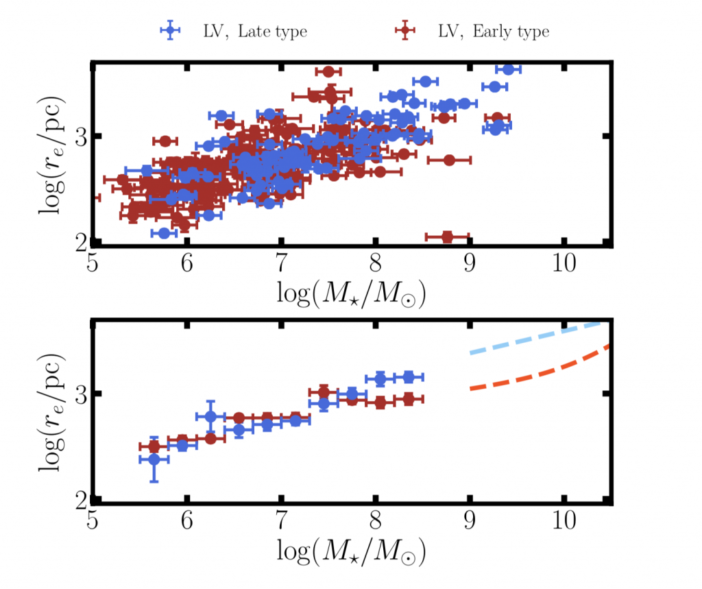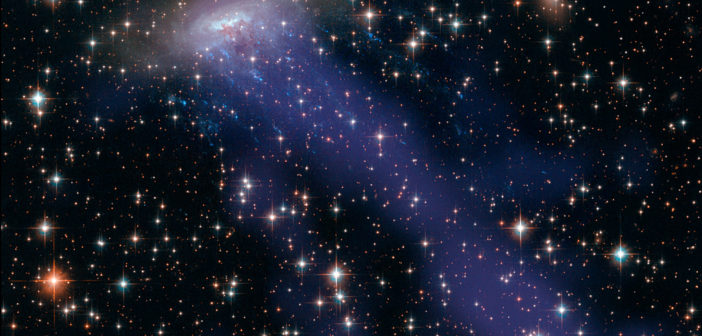Editor’s note: Astrobites is a graduate-student-run organization that digests astrophysical literature for undergraduate students. As part of the partnership between the AAS and astrobites, we occasionally repost astrobites content here at AAS Nova. We hope you enjoy this post from astrobites; the original can be viewed at astrobites.org.
Title: ELVES I: Structures of Dwarf Satellites of MW-like Galaxies; Morphology, Scaling Relations, and Intrinsic Shapes
Authors: Scott G. Carlsten et al.
First Author’s Institution: Princeton University
Status: Accepted to ApJ
Dwarf galaxies are thought to be incredibly suggestible; there has been a range of diverse dwarf galaxies observed in our universe, indicating that they are extremely sensitive to their surroundings. The observed differences in sizes, shapes, and colours of dwarf galaxies is believed to be at least in part due to differences in the environment they inhabit. All galaxies are thought to be surrounded by a halo of dark matter (see this astrobite for more details). Many dwarf galaxies are satellite galaxies, meaning that they are found in orbit within a larger host dark matter halo that also typically contains a larger central galaxy (for example, the Small and Large Magellanic Clouds are satellite galaxies, both in orbit of our own Milky Way).
Satellite galaxies are subject to many different interactions with their host dark matter halo. These interactions between a satellite galaxy and its host can have devastating effects on the satellite galaxy itself. For example, their gas content can become extremely disturbed (and sometimes completely removed) by ram pressure stripping, which can eventually bring star formation in the satellite to a halt (see this astrobite for a summary of the seminal paper on ram pressure stripping). Similarly, their stars are subject to tidal stripping, which arises due to differences in the gravitational potential of the satellite galaxy and its host.

Figure 1: Examples of dwarfs visually classified as early-type (ETG) and late-type (LTG). Late-type dwarfs are irregular, with apparent active star formation throughout the galaxy while early-types are smooth and featureless without any star-forming clumps. [Carlsten et al. 2021]
Going from a Late-type to an Early-type?
The current picture of dwarf galaxy evolution suggests that early-type dwarfs are formed from late-type dwarfs interacting with a host halo. If this is the case, then early-type dwarfs can be thought of as dwarf galaxies in the last throes of their evolution, and any differences in characteristics of late-type and early-type galaxies could provide insights into the physical mechanisms behind this evolution (such as the removal of star-forming gas through ram pressure stripping).

Figure 2: Log effective radius vs. log stellar mass for the dwarf galaxies in the Local Volume sample. The upper panel displays points for each dwarf galaxy in the sample, with red indicating early-type and blue indicating late-type. The bottom panel shows average trends binned by stellar mass. The dashed lines show the mass-size relations for early-type (red) and late-type (blue) dwarf galaxies of higher stellar mass from the GAMA Survey. [Adapted from Carlsten et al. 2021]
Environmental Effects
The next question the authors aim to answer is: how does the mass of the dwarf galaxy’s host dark matter halo affect the evolution of the dwarf galaxy? To consider this, the authors again compare the sizes of dwarf galaxies. This time, a comparison is made between dwarf galaxies that are orbiting within larger cluster environments and the dwarf galaxies in their Local Volume environment.

Figure 3: The mass–size relations of the cluster (grey) and field (cyan) dwarf samples normalized to the full Local Volume sample (green). At fixed stellar mass, the cluster sample is offset to larger sizes, whereas the isolated field sample is offset to smaller sizes. Field galaxies are isolated dwarf galaxies that have been taken from an auxiliary sample, using additional observational data. [Adapted from Carlsten et al. 2021]
In conclusion, today’s authors are able to gain insights into the physics of dwarf galaxy transformation from late-types to early-types, and how these processes vary between the Milky Way-like and cluster environments. The authors comment that a comparison with simulations will be useful in constraining the physics of how dwarf galaxies evolve. Their observational results have quantified the start and end points of the transformation, and simulations may now be able to tie them together to tell the middle part of the story!
Original astrobite edited by Luna Zagorac.
About the author, Katy Proctor:
I am a first-year PhD student at the International Centre for Radio Astronomy Research at the University of Western Australia. My research is focused on using cosmological simulations to study the evolution of satellite galaxies. Outside of research, I can usually be found climbing up walls or playing guitar.
